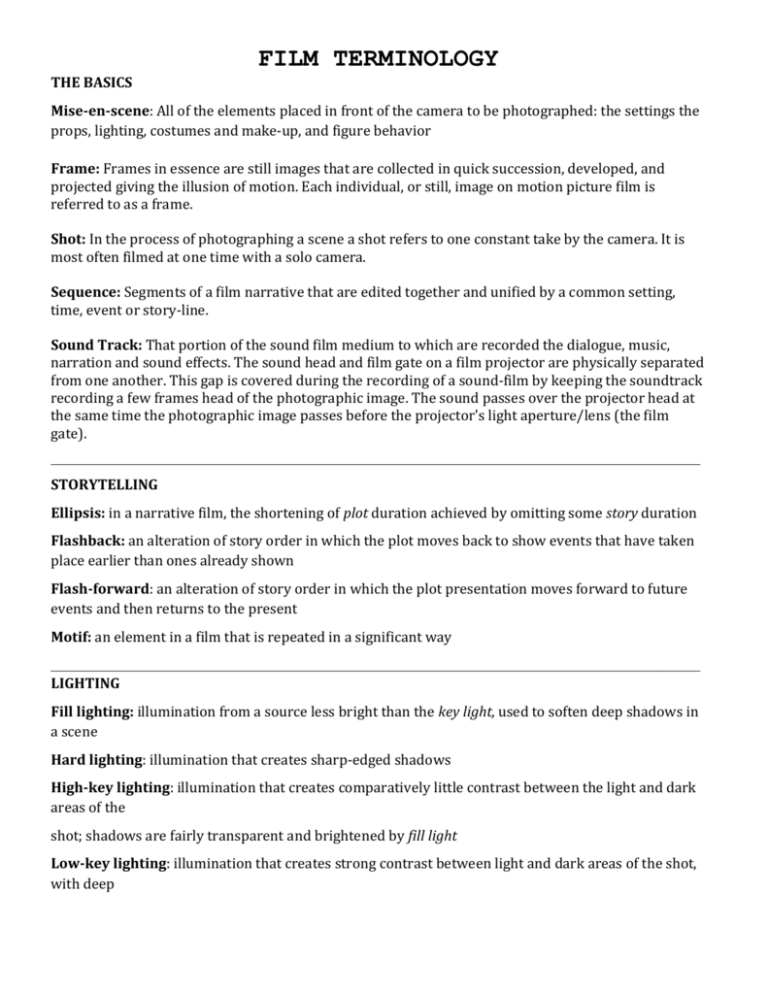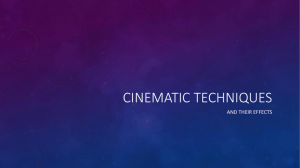film terminology
advertisement

FILM TERMINOLOGY THE BASICS Mise-en-scene: All of the elements placed in front of the camera to be photographed: the settings the props, lighting, costumes and make-up, and figure behavior Frame: Frames in essence are still images that are collected in quick succession, developed, and projected giving the illusion of motion. Each individual, or still, image on motion picture film is referred to as a frame. Shot: In the process of photographing a scene a shot refers to one constant take by the camera. It is most often filmed at one time with a solo camera. Sequence: Segments of a film narrative that are edited together and unified by a common setting, time, event or story-line. Sound Track: That portion of the sound film medium to which are recorded the dialogue, music, narration and sound effects. The sound head and film gate on a film projector are physically separated from one another. This gap is covered during the recording of a sound-film by keeping the soundtrack recording a few frames head of the photographic image. The sound passes over the projector head at the same time the photographic image passes before the projector's light aperture/lens (the film gate). __________________________________________________________________________________________ STORYTELLING Ellipsis: in a narrative film, the shortening of plot duration achieved by omitting some story duration Flashback: an alteration of story order in which the plot moves back to show events that have taken place earlier than ones already shown Flash-forward: an alteration of story order in which the plot presentation moves forward to future events and then returns to the present Motif: an element in a film that is repeated in a significant way __________________________________________________________________________________________ LIGHTING Fill lighting: illumination from a source less bright than the key light, used to soften deep shadows in a scene Hard lighting: illumination that creates sharp-edged shadows High-key lighting: illumination that creates comparatively little contrast between the light and dark areas of the shot; shadows are fairly transparent and brightened by fill light Low-key lighting: illumination that creates strong contrast between light and dark areas of the shot, with deep FILM TERMINOLOGY shadows and little fill light Under-lighting: illumination from a point below the figures in the scene _________________________________________________________________________________________ CAMERA ANGLES/ SHOTS/ FRAMES Angle of framing: the position of the frame in relation to the subject it shows: Also called camera angle above it, looking down (a high angle) below it, looking up (a low angle) Bird’s Eye: extremely disorienting; viewer is God-like Boom: when the camera moves up or down, as if it were on a physical crane Canted framing: a view in which the frame is not level; either the right or the left side is lower than the other, causing objects in the scene to appear slanted out of an upright position (deliberately slanted to one side, sometimes used for dramatic effect to help portray unease, disorientation, frantic or desperate action, intoxication, madness, etc.) Close-up: a framing in which the scale of the object shown is relatively large; most commonly, a person’s head seen from the neck up, or an object of a comparable size that fills most of the screen (adds importance to the object being; shows very little background) Crane shot: a shot with a change in framing accomplished by placing the camera above and moving through the air in any direction Crosscutting: editing that alternates shots of two or more lines of action occurring in different places, usually simultaneously Cut-in: an instantaneous shift from a distant framing to a closer view of some portion of the same space Deep focus: a use of the camera lens and lighting that keeps objects in both close and distant planes in sharp focus Dolly shot: the camera moves backwards from an interior shot of a couple arguing in their car, to an exterior shot of their car stuck in a traffic jam Establishing shot: a shot, usually involving a distant framing, that shows the spatial relations among the important figures, objects, and setting in a scene FILM TERMINOLOGY Extreme close up: a framing in which the scale of the object shown is very large; most commonly, a small object or a part of the body (magnifying beyond what the human eye would experience in reality) Extreme long shot: a framing in which the scale of the object shown is very small; a building, landscape, or crowd of people will fill the screen Following shot: a shot with framing that shifts to keep a moving figure onscreen High angle: the camera looks down on the subject; takes away power from a subject; makes subject appear insignificant Long shot: a framing in which the scale of the object shown is very small; a standing human figure would appear nearly half the height of the screen (is often used to show scenes of thrilling action e.g. in a war film or disaster movie; there will be very little detail visible in the shot) Low angle: an angle is a shot from a camera angle positioned low on the vertical axis, anywhere below the eyeline, looking up; increases height/power of the subject Medium close-up: a framing in which the scale of the object shown is fairly large; a human figure seen from the chest up would fill most the screen Medium long shot: a framing at a distance that makes an object about four or five feet high appear to fill most of the screen vertically. Medium shot: a framing in which the scale of the object shown is of moderate size; a human figure seen from the waist up would fill most of the screen (may show two people full-figured or three people from the waist up) Over-the-Shoulder: This shot is framed from behind a person who is looking at the subject. This shot helps to establish the position of each person, and get the feel of looking at one person from the other's point of view. It's common to cut between these shots during a conversation Pan: a camera movement with the camera body turning to the right or left; on the screen, it produces a mobile framing that scans the space horizontally (ex: panning across a landscape) Point-of-view (POV) shot: a shot taken with the camera placed approximately where the character’s eyes would be, showing what the character would see; usually cut in before or after a shot of the character looking FILM TERMINOLOGY Reestablishing shot: a return to a view of an entire space after a series of closer following the establishing shot Straight-on: camera head is at eye-level Tilt: a camera movement with the camera swiveling upward or downward on a stationary support. It produces a mobile framing that scans the space vertically (ex: the shot follows Spiderman as he climbs up the side of a building) Tracking shot: a mobile framing that travels through space forward, backward, or laterally. See also crane shot, pan, and tilt (ex: camera moves from left to right, following the hero as she runs on top of a moving train) __________________________________________________________________________________________ SOUNDTRACK AND SOUNDS Diegetic sound: Any voice, musical passage, or sound effect presented as originating from a source within the film's world. Nondiegetic sound: Sound, such as mood music or narrator's commentary, represented as coming from a source outside the space of the narrative. Offscreen sound: simultaneous sound from a source assumed to be in the space of the scene but outside what is visible onscreen Sound bridge: (1) at the beginning of a scene, the sound from the previous scene carries over briefly before the sound from the new scene begins (2) at the end of one scene the sound from the next scene is heard, leading into that scene Sound over: any sound that is not represented as coming from the space and time of the images on the screen; this includes both non-diegetic sounds and nonsimultaneous diegetic sound __________________________________________________________________________________________ EDITING TECHNIQUES & TRANSITIONS Cut: (1) in filmmaking, the joining of two strips of film together with a splice (2) in the finished film, an instantaneous change from one framing to another Dissolve: a transition between two shots during which the first image gradually disappears while the second image gradually appears for a moment the two images blend in superimposition Elliptical editing: shot transitions that omit parts of an event, causing an ellipsis in plot duration FILM TERMINOLOGY Fade: (1) fade-in: a dark screen the gradually brightens as a shot appears (2) fade-out: a shot that gradually disappears as the screen darkens; occasionally, fade-outs brighten to pure white or to a color Jump cut: an elliptical cut that appears to be an interruption of a single shot; either the figures seem to change instantly against a constant background, or the background changes instantly while the figures remain constant Montage: (1) a synonym for editing (2) an approach to editing developed by the Soviet fimmakers of the 1920s; it emphasizes dynamic, often discontinuous, relationships between shots and the juxtaposition of images to create ideas not present in either shot by itself Overlapping editing: cuts that repeat part of all of an action, thus expanding its viewing time and plot duration Wipe: a transition between shots in which a line passes across the screen, eliminating one shot as it goes and replacing it with the next one




